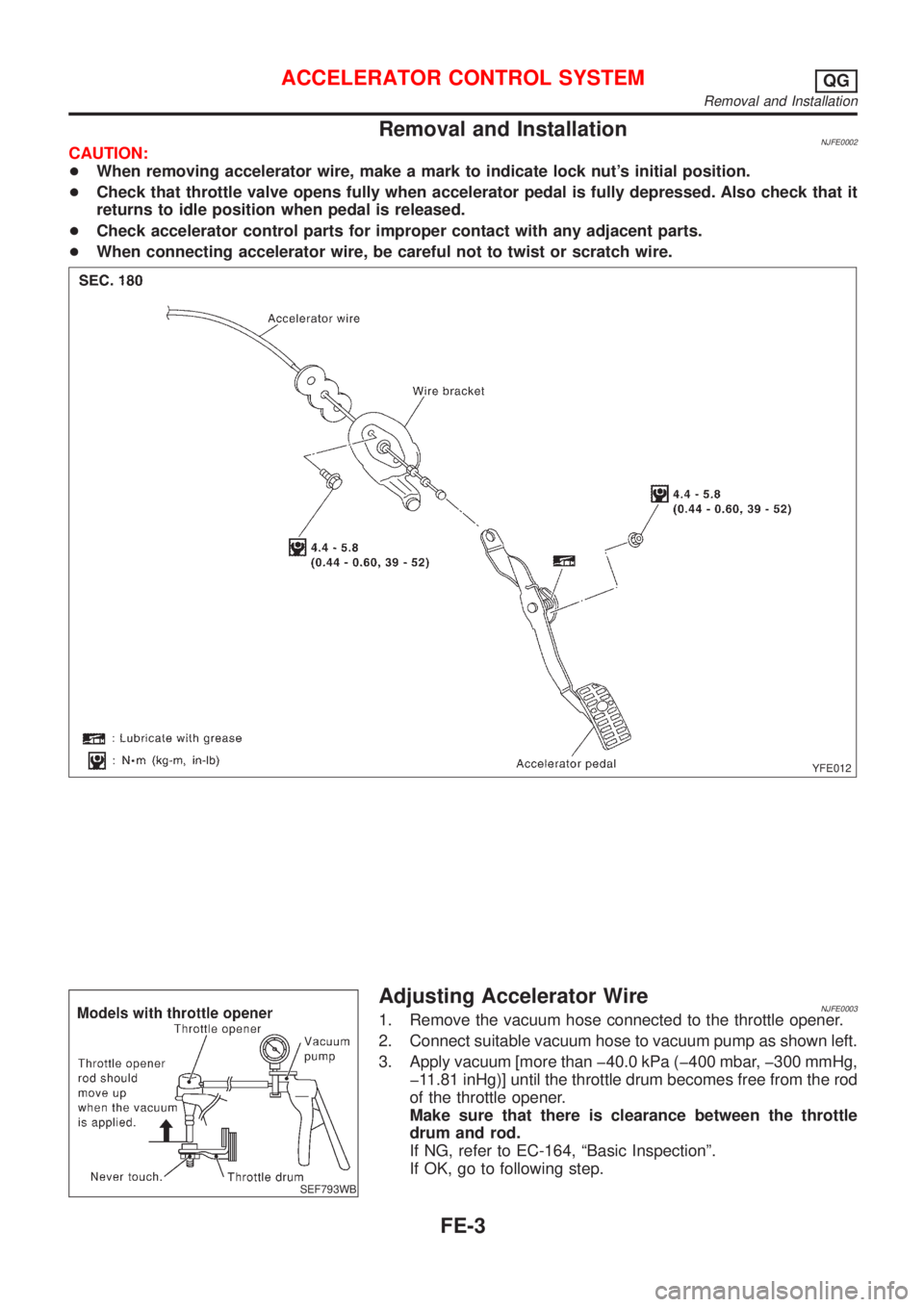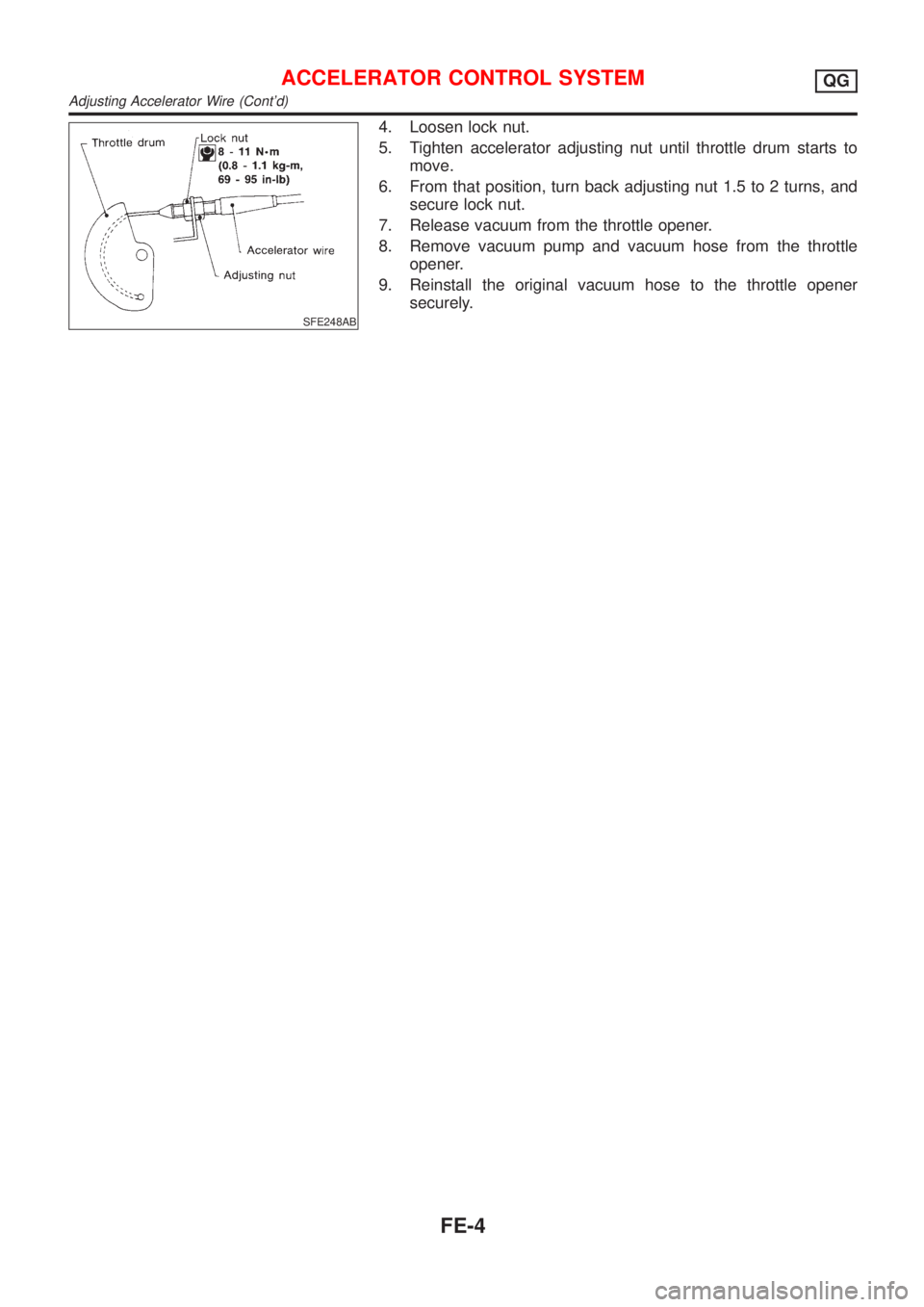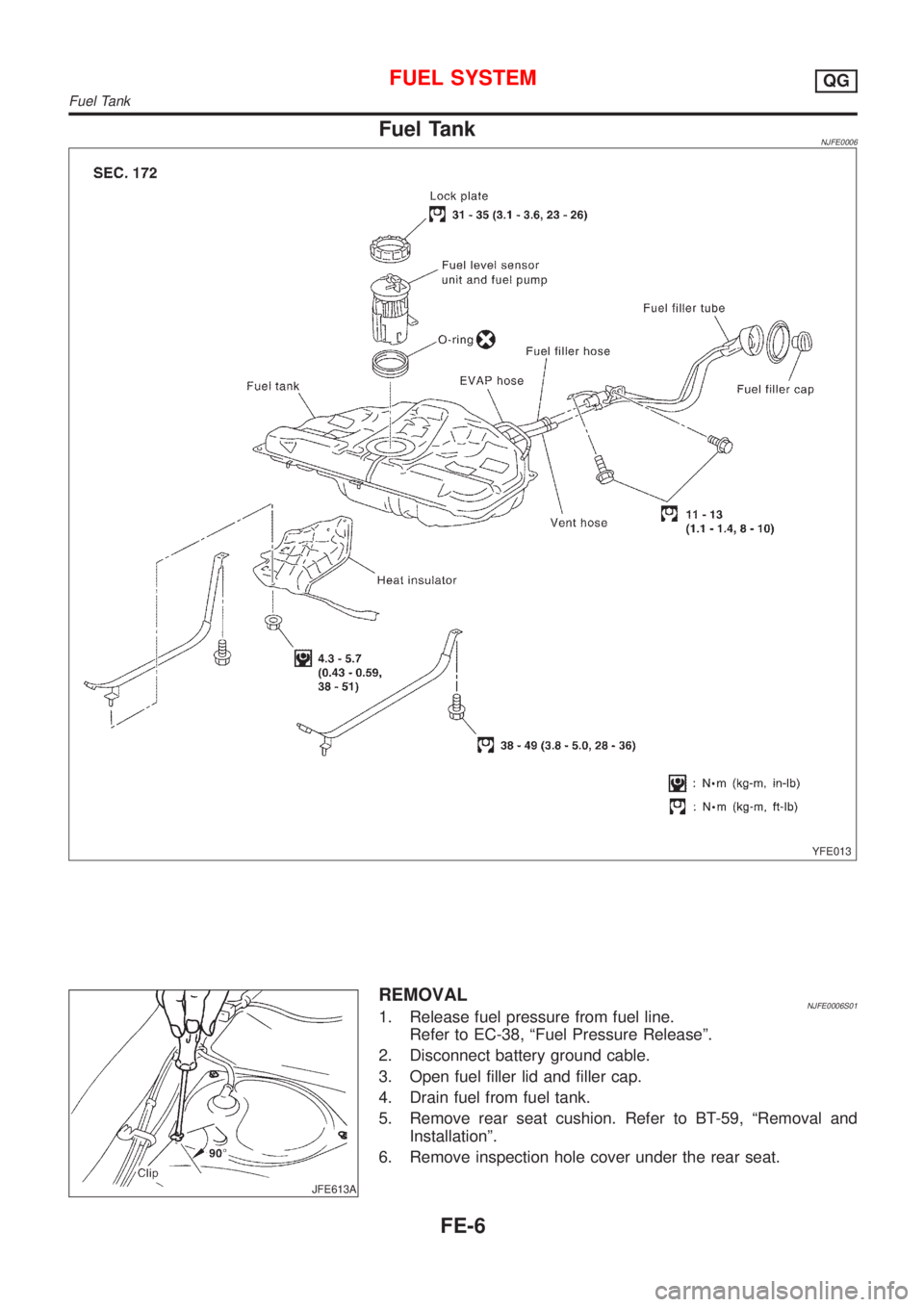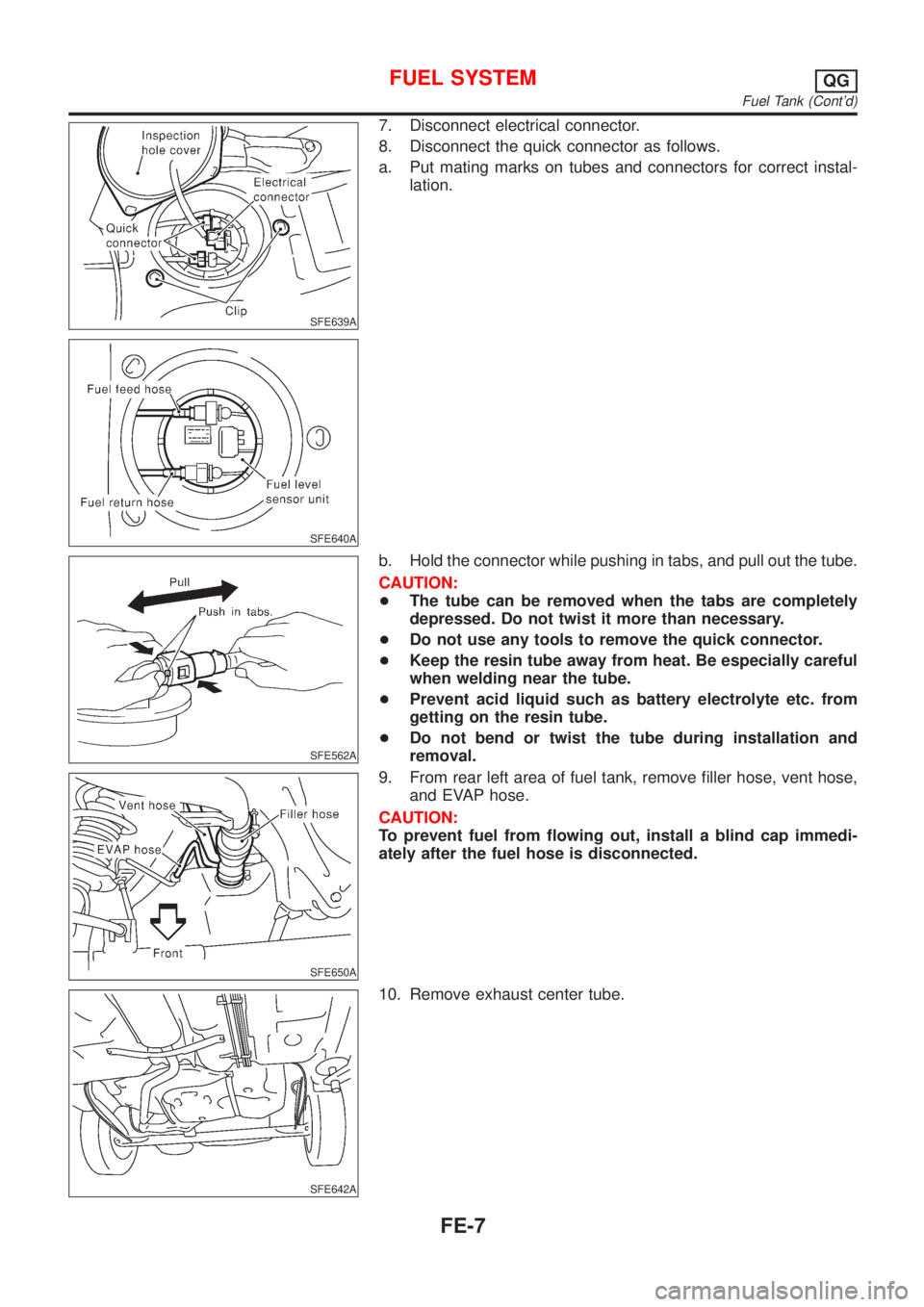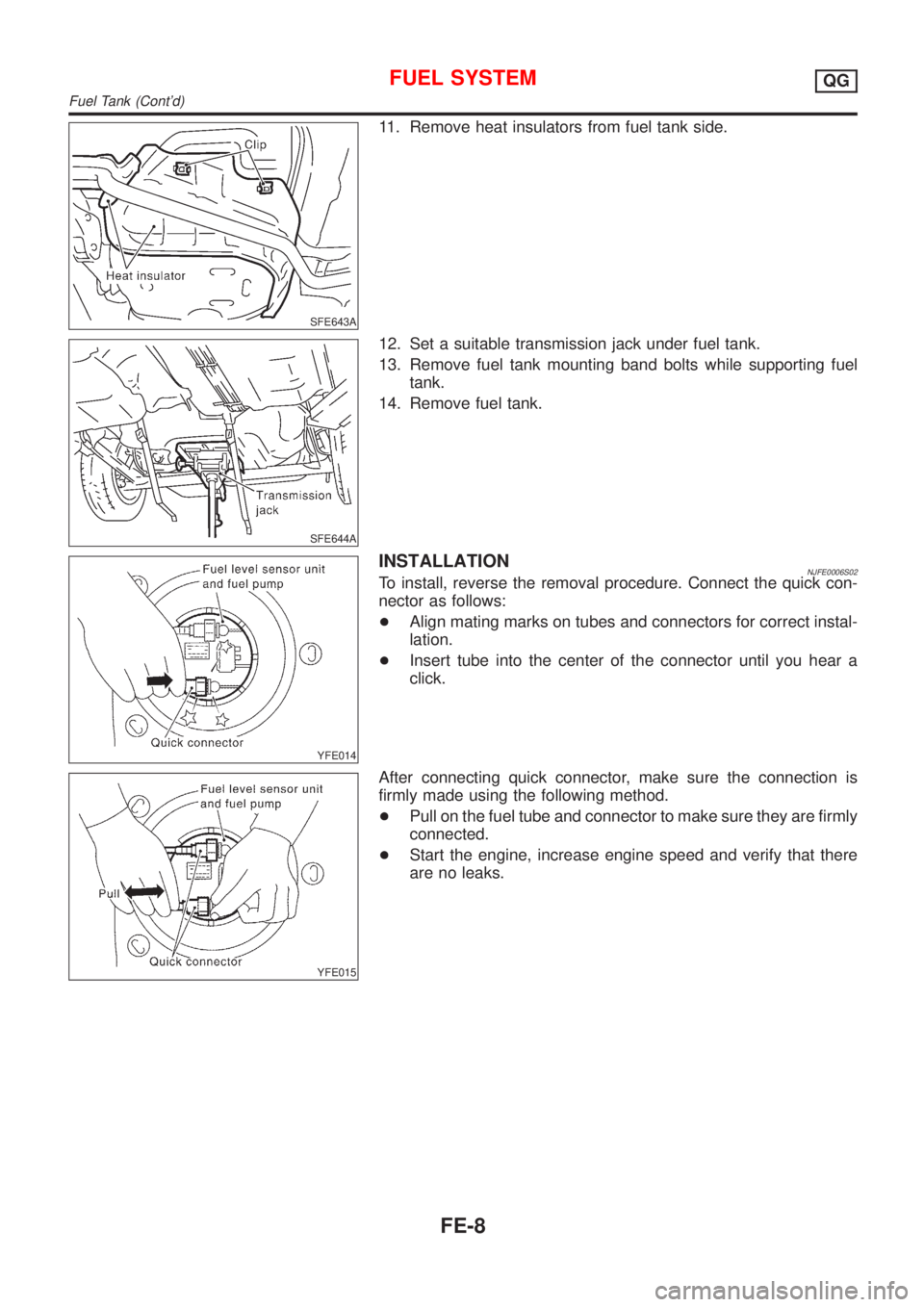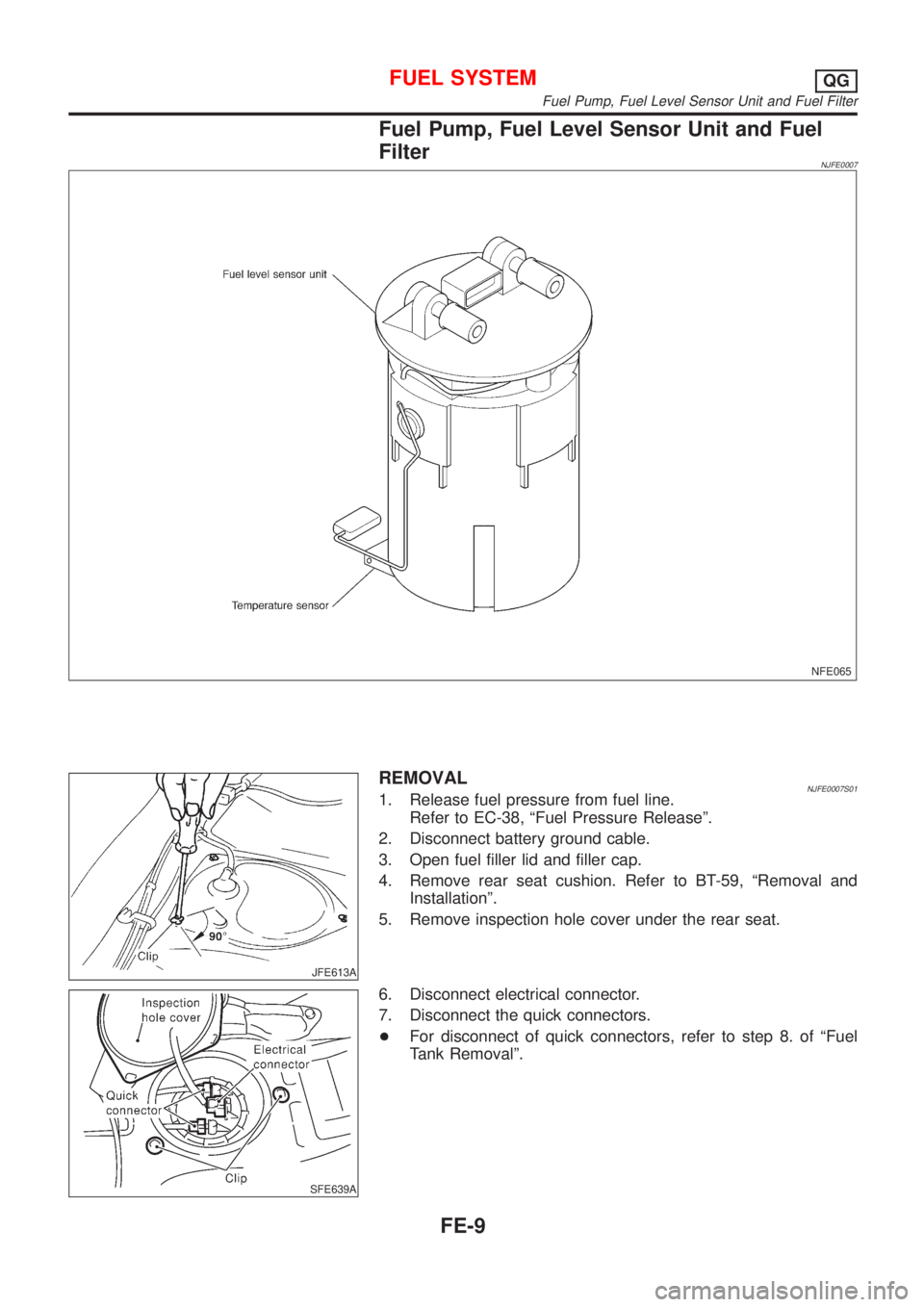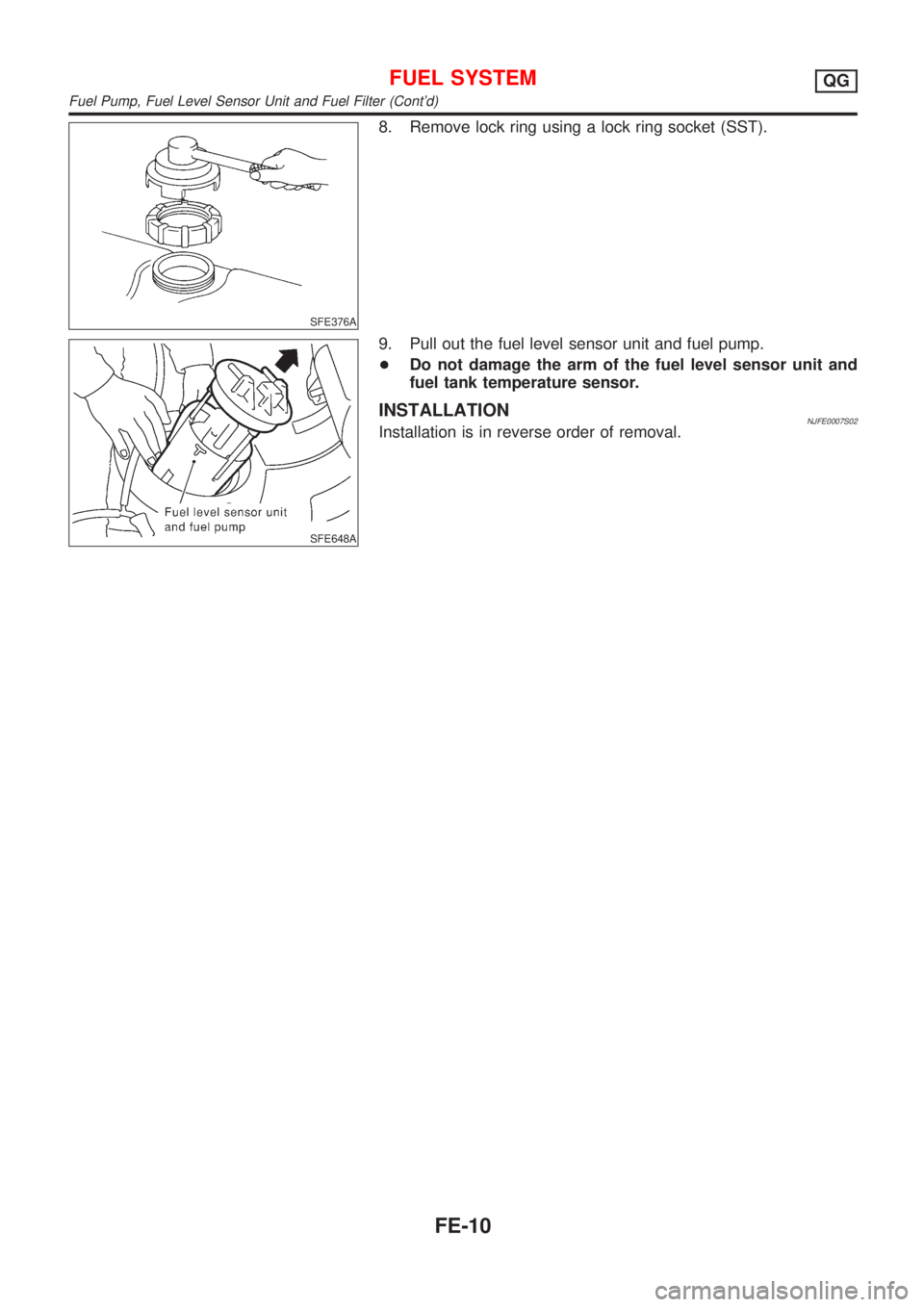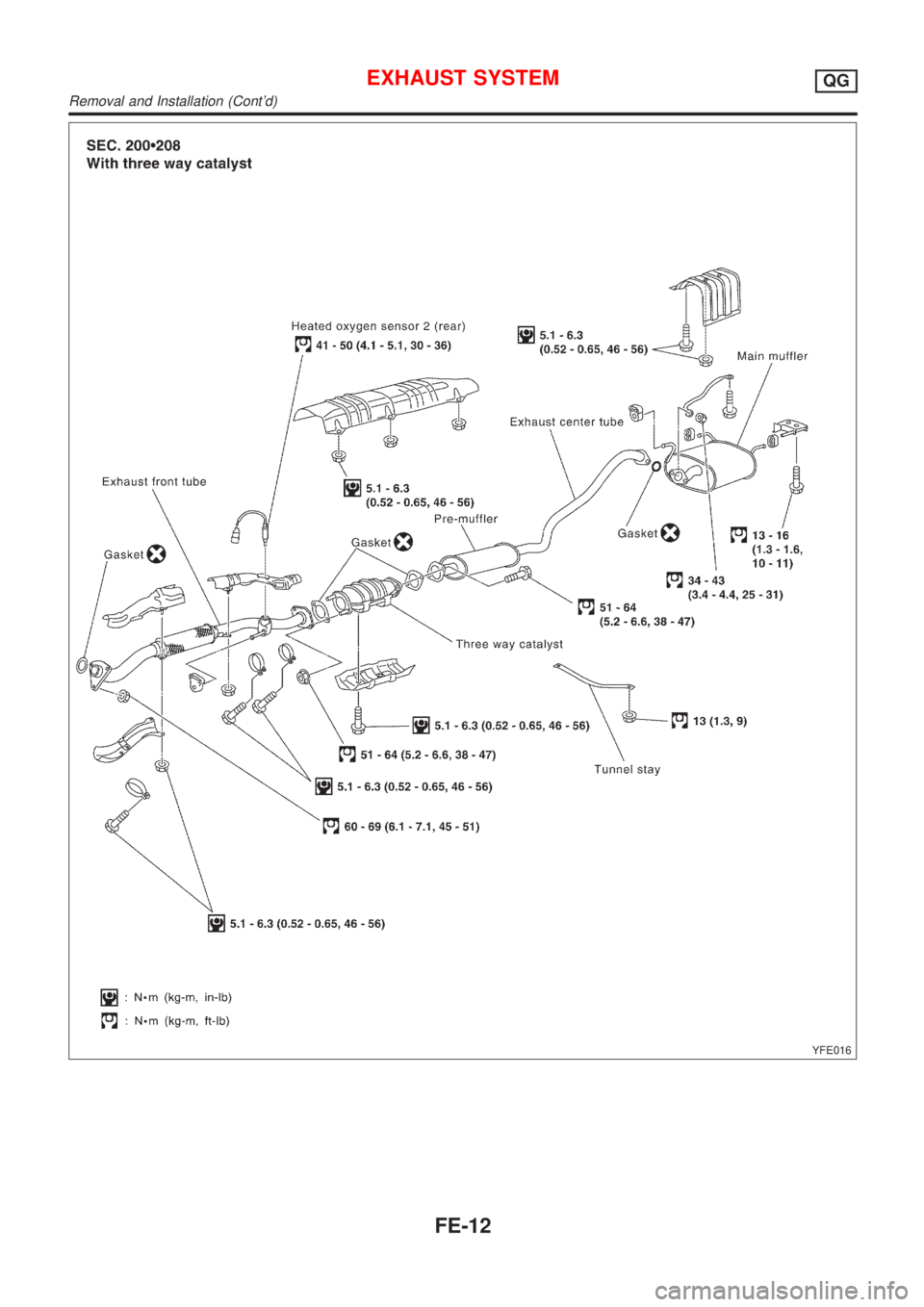NISSAN ALMERA N16 2001 Electronic Repair Manual
ALMERA N16 2001
NISSAN
NISSAN
https://www.carmanualsonline.info/img/5/57351/w960_57351-0.png
NISSAN ALMERA N16 2001 Electronic Repair Manual
Trending: check engine light, Parking, EL-53, steering wheel, oil level, navigation system, Idle control valve
Page 1001 of 2493
Removal and InstallationNJFE0002CAUTION:
+When removing accelerator wire, make a mark to indicate lock nut's initial position.
+Check that throttle valve opens fully when accelerator pedal is fully depressed. Also check that it
returns to idle position when pedal is released.
+Check accelerator control parts for improper contact with any adjacent parts.
+When connecting accelerator wire, be careful not to twist or scratch wire.
YFE012
SEF793WB
Adjusting Accelerator WireNJFE00031. Remove the vacuum hose connected to the throttle opener.
2. Connect suitable vacuum hose to vacuum pump as shown left.
3. Apply vacuum [more than þ40.0 kPa (þ400 mbar, þ300 mmHg,
þ11.81 inHg)] until the throttle drum becomes free from the rod
of the throttle opener.
Make sure that there is clearance between the throttle
drum and rod.
If NG, refer to EC-164, ªBasic Inspectionº.
If OK, go to following step.
ACCELERATOR CONTROL SYSTEMQG
Removal and Installation
FE-3
Page 1002 of 2493
SFE248AB
4. Loosen lock nut.
5. Tighten accelerator adjusting nut until throttle drum starts to
move.
6. From that position, turn back adjusting nut 1.5 to 2 turns, and
secure lock nut.
7. Release vacuum from the throttle opener.
8. Remove vacuum pump and vacuum hose from the throttle
opener.
9. Reinstall the original vacuum hose to the throttle opener
securely.
ACCELERATOR CONTROL SYSTEMQG
Adjusting Accelerator Wire (Cont'd)
FE-4
Page 1003 of 2493
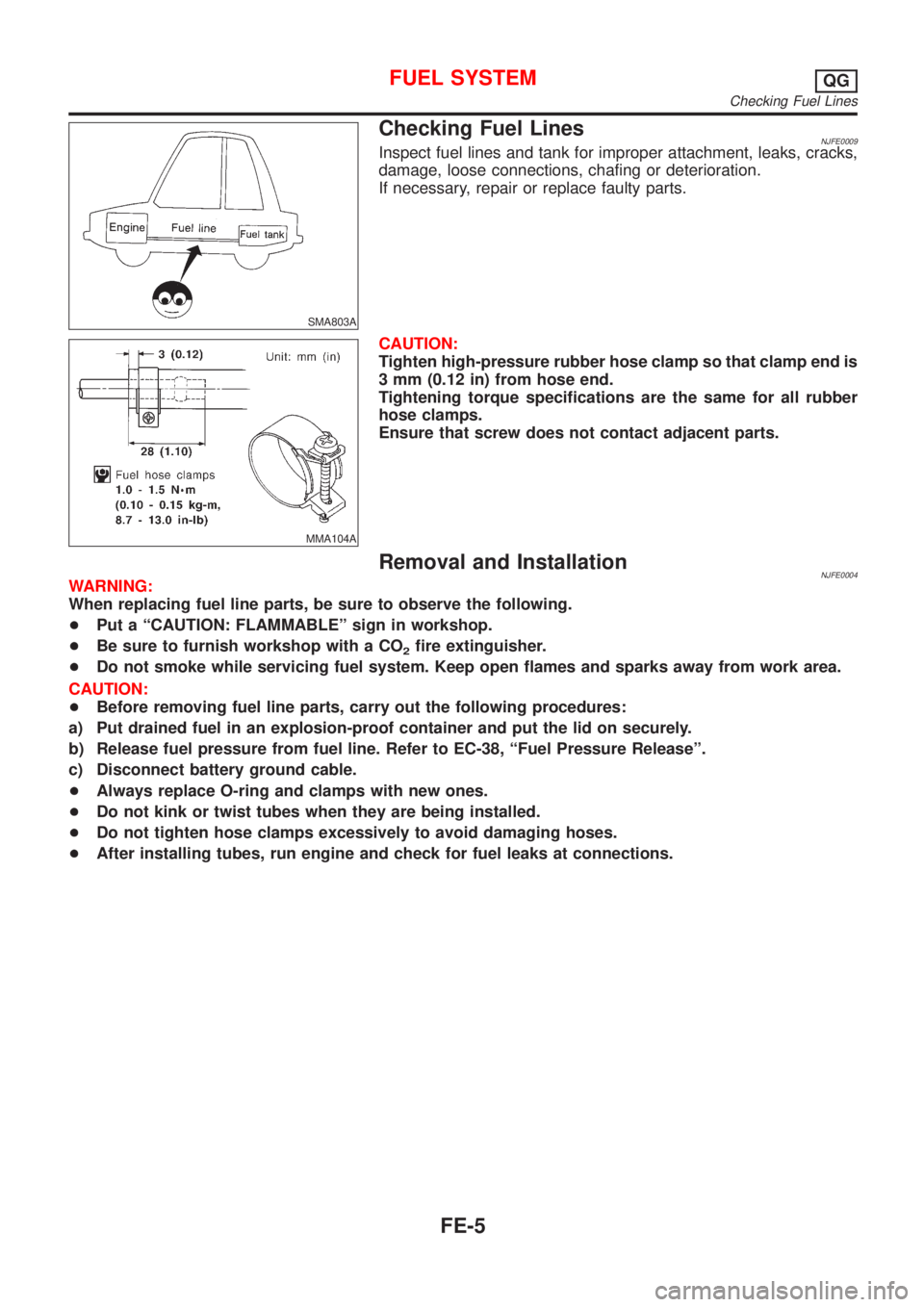
SMA803A
Checking Fuel LinesNJFE0009Inspect fuel lines and tank for improper attachment, leaks, cracks,
damage, loose connections, chafing or deterioration.
If necessary, repair or replace faulty parts.
MMA104A
CAUTION:
Tighten high-pressure rubber hose clamp so that clamp end is
3 mm (0.12 in) from hose end.
Tightening torque specifications are the same for all rubber
hose clamps.
Ensure that screw does not contact adjacent parts.
Removal and InstallationNJFE0004WARNING:
When replacing fuel line parts, be sure to observe the following.
+Put a ªCAUTION: FLAMMABLEº sign in workshop.
+Be sure to furnish workshop with a CO
2fire extinguisher.
+Do not smoke while servicing fuel system. Keep open flames and sparks away from work area.
CAUTION:
+Before removing fuel line parts, carry out the following procedures:
a) Put drained fuel in an explosion-proof container and put the lid on securely.
b) Release fuel pressure from fuel line. Refer to EC-38, ªFuel Pressure Releaseº.
c) Disconnect battery ground cable.
+Always replace O-ring and clamps with new ones.
+Do not kink or twist tubes when they are being installed.
+Do not tighten hose clamps excessively to avoid damaging hoses.
+After installing tubes, run engine and check for fuel leaks at connections.
FUEL SYSTEMQG
Checking Fuel Lines
FE-5
Page 1004 of 2493
Fuel TankNJFE0006
YFE013
JFE613A
REMOVALNJFE0006S011. Release fuel pressure from fuel line.
Refer to EC-38, ªFuel Pressure Releaseº.
2. Disconnect battery ground cable.
3. Open fuel filler lid and filler cap.
4. Drain fuel from fuel tank.
5. Remove rear seat cushion. Refer to BT-59, ªRemoval and
Installationº.
6. Remove inspection hole cover under the rear seat.
FUEL SYSTEMQG
Fuel Tank
FE-6
Page 1005 of 2493
SFE639A
SFE640A
7. Disconnect electrical connector.
8. Disconnect the quick connector as follows.
a. Put mating marks on tubes and connectors for correct instal-
lation.
SFE562A
b. Hold the connector while pushing in tabs, and pull out the tube.
CAUTION:
+The tube can be removed when the tabs are completely
depressed. Do not twist it more than necessary.
+Do not use any tools to remove the quick connector.
+Keep the resin tube away from heat. Be especially careful
when welding near the tube.
+Prevent acid liquid such as battery electrolyte etc. from
getting on the resin tube.
+Do not bend or twist the tube during installation and
removal.
SFE650A
9. From rear left area of fuel tank, remove filler hose, vent hose,
and EVAP hose.
CAUTION:
To prevent fuel from flowing out, install a blind cap immedi-
ately after the fuel hose is disconnected.
SFE642A
10. Remove exhaust center tube.
FUEL SYSTEMQG
Fuel Tank (Cont'd)
FE-7
Page 1006 of 2493
SFE643A
11. Remove heat insulators from fuel tank side.
SFE644A
12. Set a suitable transmission jack under fuel tank.
13. Remove fuel tank mounting band bolts while supporting fuel
tank.
14. Remove fuel tank.
YFE014
INSTALLATIONNJFE0006S02To install, reverse the removal procedure. Connect the quick con-
nector as follows:
+Align mating marks on tubes and connectors for correct instal-
lation.
+Insert tube into the center of the connector until you hear a
click.
YFE015
After connecting quick connector, make sure the connection is
firmly made using the following method.
+Pull on the fuel tube and connector to make sure they are firmly
connected.
+Start the engine, increase engine speed and verify that there
are no leaks.
FUEL SYSTEMQG
Fuel Tank (Cont'd)
FE-8
Page 1007 of 2493
Fuel Pump, Fuel Level Sensor Unit and Fuel
Filter
NJFE0007
NFE065
JFE613A
REMOVALNJFE0007S011. Release fuel pressure from fuel line.
Refer to EC-38, ªFuel Pressure Releaseº.
2. Disconnect battery ground cable.
3. Open fuel filler lid and filler cap.
4. Remove rear seat cushion. Refer to BT-59, ªRemoval and
Installationº.
5. Remove inspection hole cover under the rear seat.
SFE639A
6. Disconnect electrical connector.
7. Disconnect the quick connectors.
+For disconnect of quick connectors, refer to step 8. of ªFuel
Tank Removalº.
FUEL SYSTEMQG
Fuel Pump, Fuel Level Sensor Unit and Fuel Filter
FE-9
Page 1008 of 2493
SFE376A
8. Remove lock ring using a lock ring socket (SST).
SFE648A
9. Pull out the fuel level sensor unit and fuel pump.
+Do not damage the arm of the fuel level sensor unit and
fuel tank temperature sensor.
INSTALLATIONNJFE0007S02Installation is in reverse order of removal.
FUEL SYSTEMQG
Fuel Pump, Fuel Level Sensor Unit and Fuel Filter (Cont'd)
FE-10
Page 1009 of 2493
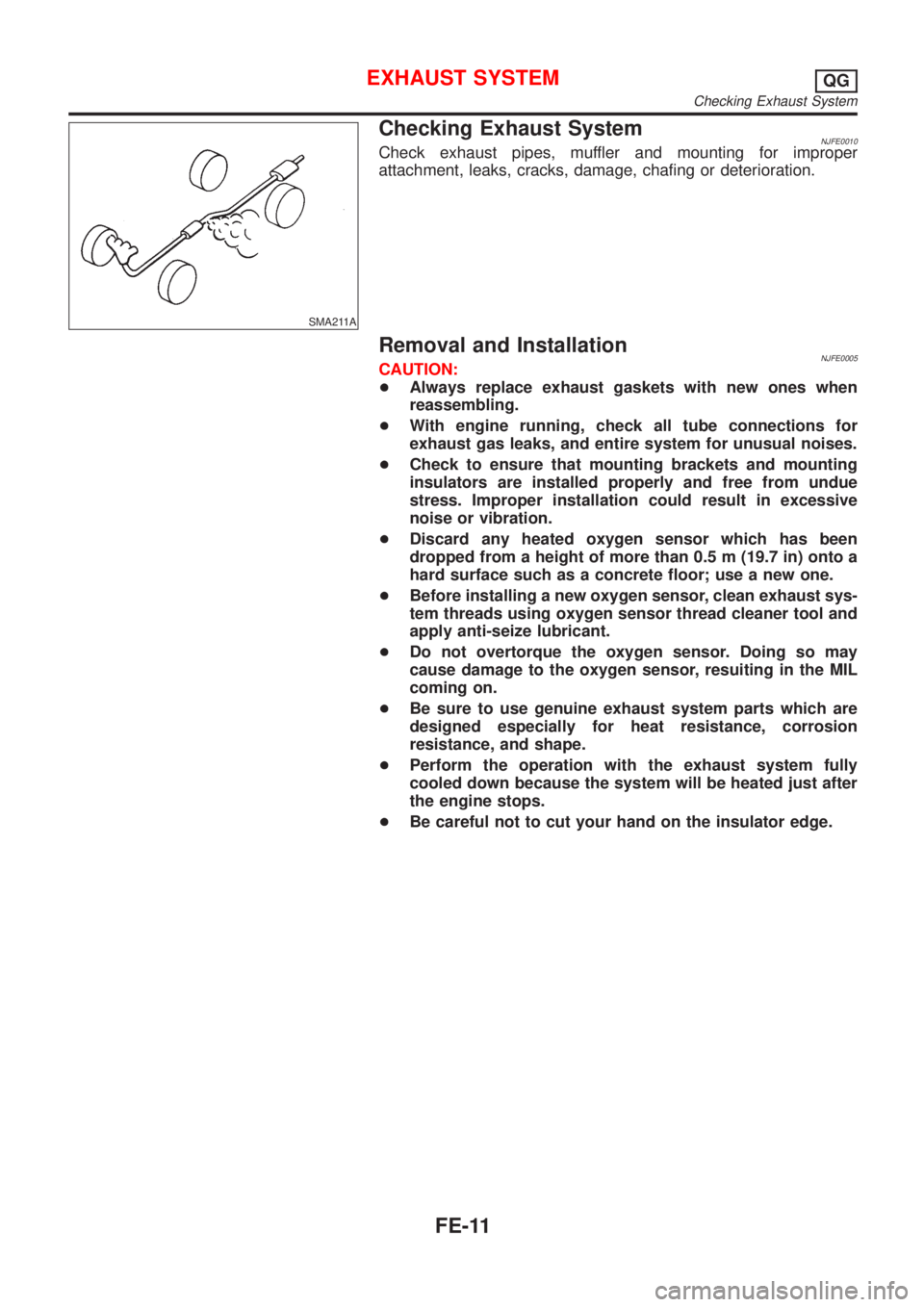
SMA211A
Checking Exhaust SystemNJFE0010Check exhaust pipes, muffler and mounting for improper
attachment, leaks, cracks, damage, chafing or deterioration.
Removal and InstallationNJFE0005CAUTION:
+Always replace exhaust gaskets with new ones when
reassembling.
+With engine running, check all tube connections for
exhaust gas leaks, and entire system for unusual noises.
+Check to ensure that mounting brackets and mounting
insulators are installed properly and free from undue
stress. Improper installation could result in excessive
noise or vibration.
+Discard any heated oxygen sensor which has been
dropped from a height of more than 0.5 m (19.7 in) onto a
hard surface such as a concrete floor; use a new one.
+Before installing a new oxygen sensor, clean exhaust sys-
tem threads using oxygen sensor thread cleaner tool and
apply anti-seize lubricant.
+Do not overtorque the oxygen sensor. Doing so may
cause damage to the oxygen sensor, resuiting in the MIL
coming on.
+Be sure to use genuine exhaust system parts which are
designed especially for heat resistance, corrosion
resistance, and shape.
+Perform the operation with the exhaust system fully
cooled down because the system will be heated just after
the engine stops.
+Be careful not to cut your hand on the insulator edge.
EXHAUST SYSTEMQG
Checking Exhaust System
FE-11
Page 1010 of 2493
YFE016
EXHAUST SYSTEMQG
Removal and Installation (Cont'd)
FE-12
Trending: window, oil change, trunk, compression ratio, driver seat adjustment, gas type, buttons
